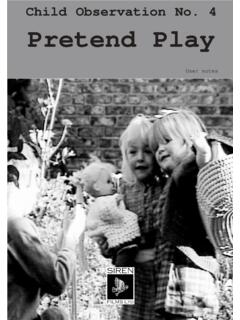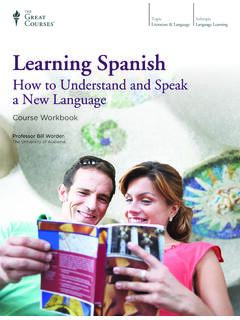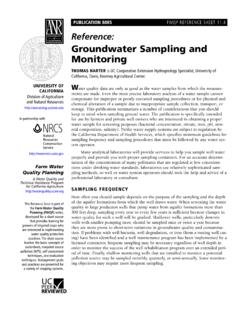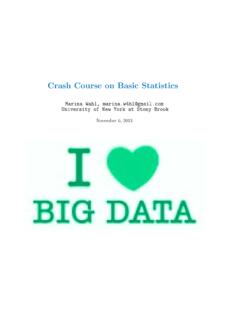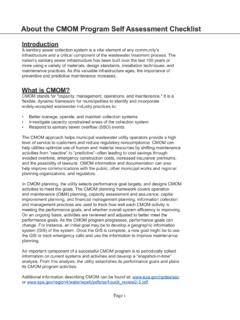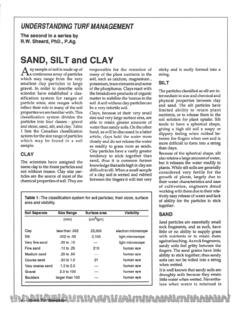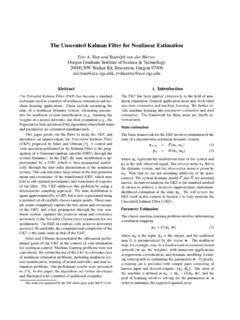Transcription of Time & Event Sampling
1 Child Observation No. 7 Time & Event SamplingUser notesContentsAims of the film & its use .. 2 The video sequences - our observations Sequence 1 - Laura - Time 4 Sequence 2 - Laura - Event 7 Sequence 3 - David - Time 11 Sequence 4 - David - Event 14 Suggested further reading .. 17 Blank observation forms .. 18 1 Aims of the film and its useA main problem of all observation is in extracting relevant information from a mass ofcomplex activity. As well as learning observation skills it is also important to be able toidentify which type of observation is required. In this tape you are shown two types ofobservation: time Sampling and Event samplingTime Sampling is often used where there is a concern about an aspect of behaviour.
2 Itinvolves observing a child for an extended period such as a whole morning/afternoonsession, or even a whole day. A record lasting for a predetermined length of time ( seconds or 1 minute) is made at regular intervals ( every 10 minutes or every hour)about what a particular child (or group of children) is doing. It is a useful technique for:! Observing a child s total behaviour and to find out what a child does typically during the course of a day.! Focusing on a selected aspect of behaviour to reveal the frequency of that behaviour.! Focusing on an activity involving a group of children using a particular resource the book or home corner, to evaluate the appropriateness of the of this technique are in being tied to clock watching and being restrict-ed to only recording events that happen in the predetermined , if appropriate it will give an objective record of behaviour and will show if con-cerns need starting any observation you must ensure that you have clear aims.
3 Without anaim and focus no useful conclusion can be samplingIn contrast to time Sampling that selects information from a stream of events, Event sam- pling concentrates on a particular short period of behaviour the Event you are inter-ested in that occurs at intervals. The length of the observation cannot be predeter-mined as it is dependent on the length of the is frequently used, for example, to observe:! Aggressive behaviour! Quarrels2! Attention seeking! Bouts of crying or comfort seekingBefore starting a full observation you will already have observed and formed possibleconcerns. With any observation a clearly defined aim will need to be identified so thatyou know exactly what you want to disadvantages are the difficulties of being constantly alert and ready to record theevent.
4 However it does give a very closely focussed view and allows that whole eventand possibly its build up to be the video sequences to use for observationsWe chose two quite different children to observe and filmed them individually for oneafternoon session at their nursery. They had both been attending the nursery every after-noon for one month. Most of the children in the class had settled in well. After consul-tation with the staff it was decided to film a very quiet girl and a lively boy who oftenseemed to be involved in disruptions. Most of the sessions involved free play and thechildren were able to wander about among the various activities staying with them aslong as they liked, playing with who ever they both children a time sample and an Event sample were filmed.
5 The purpose of thiswas twofold; to provide examples of both techniques and also to compare the informa-tion that was gathered from the two the video with studentsFirstly you can talk about the aims of the observations. Then you may wish to look at thesequences one clip at a time, perhaps repeating the clip to allow students more time toobserve properly what is happening. The clips are numbered in the top left of the pic-ture to make it easier to find the right bit if you rewind, and to link it with the observationin these dvd can be paused between clips to allow students either to write down their ownobservations, or to look at the observations we have made in these notes. You may pho-tocopy these notes for students to use.
6 There are also blank observation forms for viewing a complete sequence of video clips you can ask students to:! Interpret the observations and/or discuss what they have learned from the observations.! Consider whether the observations meet the aims set out at the start of the sequence.! Discuss how appropriate the particular observation method was.! Discuss other situations where the particular observation method could be video sequencesOur observationsSequence 1 Laura Time SampleBackground to observationLaura is a 3 years 9 months girl who has been attending the nursery in the afternoons for4 weeks. The staff were concerned because she didn t speak or answer them whenthey tried to talk to her and she also seemed to be very withdrawn not seeming tosocialise with the other children.
7 Staff had even begun to wonder if she was deaf. Thesessions are mainly free play and the children are free to choose from the availableactivities. There are 20 children and 2 see how Laura spends her time and see if she speaks or socialises with the other chil-dren and/or was observed every 10 minutes for 30 seconds over a 2 hour period. Abbreviations:TT == tteeaacchheerr,, LL == & settingOthers presentActions & pmClassroom incircleTeacher andhalf of classGeneral chatter as T talks togroup. L sitting cross-leggedwatching what s going pm Home cornerAloneL stands behind counter watchinginto main classroom doing nothing. pm Home cornerOne girl Girl speaks to L. L makes eye contact then looks away andwatches others.
8 Then she turnsback and smiles submissively(mouth corners not turned up)None4 Laura - Time Sample InterpretationLaura spent almost all the free play period in the home corner, mostly on her own behinda counter in an isolating position. Nearly all the time she is watching the other pm Home cornerAloneL stands behind counter picking upitems under the counter andwatching others pmHome cornerOne stands behind counter andwatches other girl standing next toher pmHome cornerTwo stands by counter holding theiron. A girl approaches her andtakes the iron off her and thenreturns it. L submissively allowsthis and stands watching the samegirl as she plays with a pm Home cornerSmall groupL stands behind counter watchingthe other children playing and interacting around pmHome cornerSmall groupL sits at the table watching theother children playing.
9 PmHome cornerTeacher andsmall groupL picking up toys. T givinginstructions to L and others. Llooks up at T and picks up pmPlaygroundwith outsideequipmentTeacher andnursery nurseand wholeclass of on rocker alone watching pmPlayground Whole classAbout to climb slide when anothergirl pushes her back and goes stands back and watches as others go in front. pmPlayground Whole classStoops at climbing frame watchingas children play inside. Turns tolook at T who smiles at but she doesn t become absorbed in play either with others or on her she is approached by other children she makes eye contact but doesn t speakand behaves very submissively allowing a toy to be taken from her without does smile and seem to be interested in the other children s the observation Laura does not - Time Sample ConclusionThe observation revealed a girl who doesn t speak to children or adults and seems ratherisolated.
10 The time sample observation is inconclusive about whether Laura does speakat all. Clearly it is possible that she did speak and/or socialised more outside the timesample periods. It is also possible that she speaks at home but not at nursery. An eventsample is likely to tell us more about Laura s socialising at 2 Laura Event SampleBackground to observationLaura is a 3 years 9 months girl who has been attending the nursery in the afternoons for4 weeks. The staff were concerned because she didn t speak or answer them whenthey tried to talk to her and she also seemed to be very withdrawn not seeming tosocialise with the other children. Staff had even begun to wonder if she was deaf. Thesessions are mainly free play and the children are free to choose from the availableactivities.
